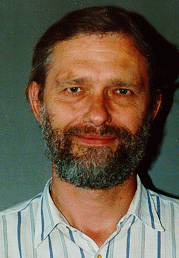|
|
24th Annual
Geometry Festival
in memory of Detlef Gromoll
SUNY Stony Brook, Stony Brook, NY
April 17-19, 2009
|

Detlef Gromoll (1938-2008) |
|
Schedule
All events will take place in S-240, on the lower ground level of the
Math Tower, unless noted otherwise.
|
|
Friday, April 17 |
| 3:30 - 4:30 PM |
Registration and Coffee
|
| 4:30 - 4:45 PM |
David Ebin, Stony Brook
Opening Remarks
|
| 4:45 - 5:45 PM |
Jeff Cheeger, New York University
Quantitative Behavior of Maps from
the Heisenberg Group to L1
Let (X,d) denote a metric space and let C
denote a collection of metrics on X such that
d'&isinC implies
c·d'&isinC for
any real number c>0.
Put &rho(d,C)=
infd'&isinC
inf{c: d' &le d &le c·d'}.
Let L denote the collection of metrics on X
of the form
d'(x1,x2)=|f(x1)-f(x2)|L1,
for some map f: X→L1, and let
N denote the collection of metrics
d on X such that (X,d1/2) embeds
isometrically in L2.
It is easy to verify that
L⊂N,
and so &rho(d,N)&le
&rho(d,L).
If X is finite with cardinality n,
it was shown by Bourgain that
&rho(d,L)=O(log n)
for any metric d.
Although the problem of computing &rho(d,L)
exactly is equivalent to other fundamental problems for which there
is believed to be no polynomial time algorithm, there
is a quadratic time algorithm for computing
&rho(d,N).
Goemans and Linial conjectured that for some universal constant C>0,
independent of n,
&rho(d,N)&le
C· &rho(d,C).
Their conjecture was refuted by Khot-Vishnoi (2005) who gave a sequence of
examples for which the best C grows at least like a constant times log(log n).
We will discuss a very difference sequence based on the Heisenberg group,
for which C grows at least like (log n)^a for some explicit a.
This is joint with with Kleiner and Naor.
It is an outgrowth of ealier work of Lee-Naor and Cheeger-Kleiner.
|
| 6:00 - 7:00 PM |
Wine and Cheese Reception
|
|
Saturday, April 18 |
| 8:30 - 9:00 AM |
Continental Breakfast
|
| 9:00 - 10:30 AM |
Wolfgang Meyer,
Westfälische Wilhelms-Universität Münster
(presented by Michael Anderson and Blaine Lawson, Stony Brook)
The Contributions of Detlef Gromoll to Riemannian Geometry
The lecture will include D. Gromoll's contributions to the
Differentable Sphere Theorem, the Diameter Rigidity Theorem, metric
fibrations, the structure theory for complete
manifolds of nonnegative sectional curvature, results for nonnegative Ricci
curvature, and closed geodesics.
Slides
|
| 11:00 - 12 noon |
Marcos Dajczer,
Instituto de Matematica Pura e Aplicada
Conformal Killing graphs with prescribed mean curvature
I will discuss the existence and uniqueness of graphs
with prescribed mean curvature function over a bounded domain in Riemannian
manifolds endowed with a conformal Killing vector field. The domain is contained
in a hypersurface in the integrable orthogonal distribution and the graph is a
hypersurface transversal to the flow lines of the field.
This is joint work with Jorge H. Lira.
|
| 2:00 - 3:00 PM |
Guofang Wei,
University of California Santa Barbara
Smooth Metric Measure Spaces
Smooth metric measure spaces are Riemannian manifolds with
a conformal change of the Riemannian measure and occur naturally as
measured Gromov-Hausdorff limit of Riemannian manifolds.
The important curvature quantity here is the Bakry-Emery Ricci tensor,
which corresponds to the (synthetic) Ricci curvature lower bound for
(nonsmooth) metric measure spaces. What geometric and topological
results for Ricci curvature can be extended to Bakry-Emery Ricci
tensor? Recently there are many developments. We will discuss
comparison geometry and rigidity in this direction.
Slides
|
| 3:30 - 4:30 PM |
Karsten Grove,
University of Notre Dame
Positive Curvature: the Quest for Examples
We will discuss recent progress including the discovery and
construction of new examples.
|
| 5:00-6:00 PM |
Dedication of Detlef Gromoll Common Room
Room 4-125, 4th floor of the Math Tower
|
| 7:00 PM |
Dinner hosted by Jim and Marilyn Simons
Three Village Inn;
pre-registration is required
|
|
Sunday, April 19 |
| 8:30 - 9:30 AM |
Continental Breakfast
|
| 9:30 - 10:30 AM |
Christina Sormani,
Lehman College and CUNY Graduate Center
The Intrinsic Flat Distance between Riemannian Manifolds
We define a new distance between oriented Riemannian manifolds that
we call the intrinsic flat distance based upon Ambrosio-Kirchheim's
theory of integral currents on metric spaces.
Limits of sequence of manifolds, with a uniform upper bound on their volumes,
the volumes of their boundaries and diameters are countably Hm
rectifiable metric spaces with an orientation and multiplicity that we call
integral current spaces.
In general the Gromov-Hausdorff and intrinsic flat limits do not agree.
However, we show that they do agree when the sequence of manifolds has
nonnegative Ricci curvature and a uniform lower bound on volume and
also when the sequence of manifolds has a uniform linear local geometric
contractibility function. These results are proven using work of Greene-Petersen,
Gromov, Cheeger-Colding and Perelman.
We present an example of three manifolds with positive scalar curvature
constructed using Gromov-Lawson connected sums attaching two standard
3 spheres with increasingly many tiny wormholes which converge in the Gromov
Hausdorff sense to the standard three sphere but in the intrinsic flat sense
to the 0 space due to the cancelling orientation of the two spheres.
We conjecture this cannot occur if we exclude spaces with interior
minimal surfaces. This is joint work with S. Wenger;
transparencies and related preprints are available
here
|
| 11:00 - 12 noon |
Gabriel Paternain,
University of Cambridge
Transparent Connections over Negatively Curved Surfaces
Let M be a closed orientable surface of negative curvature.
A unitary connection on a Hermitian vector bundle is said to be transparent
if its parallel transport along closed geodesics of g is the identity.
In this talk I will try to show that SU(2)-transparent connections can be
understood in terms of B\"acklund transformations and
that the trivial connection is locally unique.
|
|
|